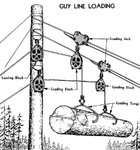I'm putting this in the rigging area because I think that's where I guessed it should go, if you want to, feel free to move it to the gear section or wherever you feel it should be (garbage can, etc lol). My day job is heavy pipe construction, and as part of our apprenticeship, they have over a year of school just on rigging. I fell in love with the problem solving that comes with it, and how every trick or technique adds together to form more and more understanding of how us weakling humans can move stuff that we can't come close to moving by hand. Yes I'm a huge nerd.
Some of the pictures and stuff aren't directly related to tree work, but then again all rigging is related, and so it could be. Quite a few of them could be rigged up at a yard, or on a trailer, and since they lack the sophisticated stuff of today's cranes they are actually quite robust, requiring little maintenance. They can be rigged with rope or wire, or even chainfalls and such. Ok here goes.
Since this is a tree forum, I'll start with ones used traditionally in logging (from what I've read). The first one is basically a gin pole, with a speedline to control the rigging point. This could be used to load or unload a trailer, and by moving the speedline around you can even change where you are placing stuff.

They are using two load lines, so you can lift level, which isn't necessary but kinda handy and cool. The next one solves that problem more elegantly by using a spider leg to pick level.
Some of the pictures and stuff aren't directly related to tree work, but then again all rigging is related, and so it could be. Quite a few of them could be rigged up at a yard, or on a trailer, and since they lack the sophisticated stuff of today's cranes they are actually quite robust, requiring little maintenance. They can be rigged with rope or wire, or even chainfalls and such. Ok here goes.
Since this is a tree forum, I'll start with ones used traditionally in logging (from what I've read). The first one is basically a gin pole, with a speedline to control the rigging point. This could be used to load or unload a trailer, and by moving the speedline around you can even change where you are placing stuff.

They are using two load lines, so you can lift level, which isn't necessary but kinda handy and cool. The next one solves that problem more elegantly by using a spider leg to pick level.















 .
.







